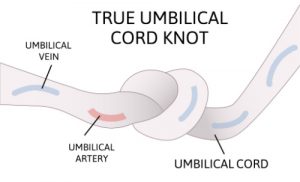
The umbilical cord is a source of nutrients and oxygen for your baby until he or she can function independently. As a result, there’s little room for error when it comes to the development and proper functioning of this crucial organ.
There are many things that may go awry during pregnancy in relation to the umbilical cord, including a cord that is too long or too short or one that becomes compressed or knotted. These issues can endanger the health of your unborn baby if left undetected.
In instances where an umbilical cord knot forms, there is a particular cause for concern. Understanding what an umbilical cord knot is and how problems with its functionality can affect your baby is essential in reducing the risk factors associated with this condition. Here is everything you need to know about umbilical cord knots and how they may affect your baby.
What Is an Umbilical Cord?
The umbilical cord is a tube of sorts that provides a flow of nutrients and oxygen from the mother to her unborn child during pregnancy via a network of blood vessels that transport blood and nutrients from the mother to the fetus via the placenta. The umbilical cord is present in every pregnancy and is usually severed right after the child is born.
The umbilical cord is usually around 18 to 22 inches long and is attached to your newborn’s abdomen and to the placenta inside your uterus. The cord contains two arteries and one vein; the arteries transfer de-oxygenated blood from the fetus back to the placenta, while in contrast, the umbilical vein transfers blood and nutrients from the placenta to the fetus. This blood flow through the umbilical cord is a continuous process throughout pregnancy.
What is an Umbilical Cord Knot?
 There are two types of conditions that may be referred to as an umbilical cord knot: false knots (pseudoknots) and true knots. Most abnormalities in the umbilical cord that are detected via imaging are false knots, which occur inside the umbilical cord and are normally comprised of swollen blood vessels or other protuberances.
There are two types of conditions that may be referred to as an umbilical cord knot: false knots (pseudoknots) and true knots. Most abnormalities in the umbilical cord that are detected via imaging are false knots, which occur inside the umbilical cord and are normally comprised of swollen blood vessels or other protuberances.
A true umbilical knot is rare, however, and occurs when the umbilical cord loops around itself inside the mother’s womb, creating an actual knot. A knot can also occur if the umbilical cord does not recoil after the baby is born, or if it becomes tangled during birth. A true umbilical cord knot occurs in only about 0.3 percent to two percent of births. This tangling of the umbilical cord may cut off the blood flow to the fetus, causing problems. If the knot is large enough, it may need to be cut out of the cord.
Umbilical cord knots are most likely to occur in breech babies delivered by cesarean section. This is because the baby comes out of the mother’s abdomen and may become entangled in the umbilical cord. In addition, if you have a twin pregnancy, your babies are at higher risk of having an umbilical cord knot.
How Can an Umbilical Cord Knot Affect Your Baby?
If an umbilical cord knot is large enough, it can cause problems, specifically, the main concern is that the fetus may not get enough oxygen. This is called fetal hypoxia, and can cause long-term problems for your child, including cerebral palsy.
Luckily, an umbilical cord knot may be discovered during routine prenatal ultrasounds. If an umbilical cord knot is detected, your healthcare provider may suggest you have a cesarean section. This is because it’s harder to untangle the umbilical cord if the knot is inside the abdomen. A c-section also allows immediate treatment if there are signs of fetal hypoxia.
Signs and Risk Factors Relating to Umbilical Cord Knot
A true umbilical cord knot usually occurs between weeks nine and 12 of pregnancy and will be visible during medical imaging before your baby is born. In some cases, if the umbilical cord is not visible, your caregiver may be able to feel the knot during delivery.
One of the most usual clues that you may have an umbilical cord knot is reduced activity or lethargy of your baby after 37 weeks. A true umbilical cord knot can cause your baby to experience low blood flow, resulting in a drop in the heart rate, difficulty breathing and excessive sleepiness. If present, upon delivery your baby may also have poor color and be lethargic and baby’s heart rate and blood pressure may be low. Talk to your caregiver immediately if you notice any of these signs.
Some of the most common risk factors for umbilical cord knot include the following.
- having a male baby
- low baby weight or length
- advanced maternal age
- particularly active baby
- high volume of amniotic fluid
- second or subsequent pregnancy
- carrying multiples (two or more babies)
While an umbilical cord knot may occur in many newborns, it is essential to note that it is not normally a cause for concern unless it is a true umbilical cord knot. If the blood vessels in the cord are not affected, a pseudoknot will typically dissolve on its own within 24 hours.


